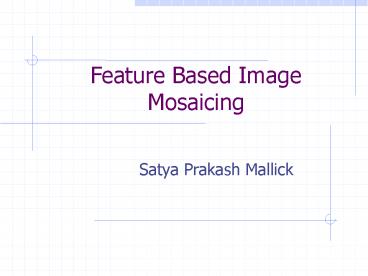Feature Based Image Mosaicing - PowerPoint PPT Presentation
Title:
Feature Based Image Mosaicing
Description:
Auto-exposure compensation. Camera error compensation. I am looking at the first four ... Corners were detected in both the images using Harris corner detector. ... – PowerPoint PPT presentation
Number of Views:720
Avg rating:3.0/5.0
Title: Feature Based Image Mosaicing
1
Feature Based Image Mosaicing
- Satya Prakash Mallick
2
Introduction
- Mosaicing methods can be classified broadly into
- Direct Method
- Uses information from all pixels.
- Iteratively updates an estimate of homography so
that a particular cost function is minimized. - Sometimes Phase-Correlation is used to estimate
the a few parameters of the homography. - Feature Based Method
- A few corresponding points are selected on the
two images and homography is estimated using
these reliable points only.
3
My Choice?
- Feature Based Method Because
- They are in general more accurate.
- Can Handle large disparities.
- Convergence Direct methods, may not converge to
the optimal solution is the presence of local
minima. - For reliable performance direct methods rely on
feature based initialization.
4
Problems in Image Mosaicing
- Global Alignment essentially means recovery of
underlying homography. - Local Alignment Correct the local mismatches
left after global alignment. - Image Blending a decision has to be made as to
what color the overlapping region should take. - Image Warping After calculation of homography, a
decision has to be made as to how to warp one
image w.r.t the other.
5
Problems in Image Mosaicing
- Automatic selection of images to blend.
- Auto-exposure compensation
- Camera error compensation.
- I am looking at the first four problems.
6
The Algorithm ( Overview )
- Detect corners in both the images
- Solve for correspondence.
- Use RANSAC to estimate homography.
- Refine the estimate of homography using a
non-linear method. - Make a decision on how to blend the images.
- Warp the one image with respect to the other
taking the blending decision into consideration
7
Solving for correspondences
- Corners were detected in both the images using
Harris corner detector. - Correspondences are solved using a version of
Zhangs relaxation algorithm - Matching Through Correlation
- Disambiguating Matches Through Relaxation
8
Solving for correspondences
- Matching through correlation
9
Solving for correspondences
- Disambiguating matches through relaxation
- Show correspondence results
10
Estimation of homography
- RANSAC was implemented for estimating the
homography relating the two scenes. Results show
a comparison between using RANSAC and Least
squares. - The error function being minimized is
11
Image Blending
- Weighted Image Blending
12
Image Blending
- Lightest Path Cut The idea is to take the
difference of the images in the overlapping
region and cut the region along that curve of
minimum intensity. The implementation was done
using dynamic programming. - Note Optimal implementation of the algorithm is
non-trivial and can be a good problem to look
into.
13
Results of Blending
- Try to find the curve along which the image
overlap was cut! ALL THE BEST!
14
Homography Refinement
- In the Weighted image blending example we saw,
there was some blurring at the edges of the
overlap. - The obvious question is
- Are we sure that the homography estimate is
good enough or can it be further refined?
15
Homography Refinement
- The Homography was refined using Newtons
non-linear optimization technique. Its safe to
use Newtons method because we are already close
to the solution. - The vector X shown is made of inliers got using
RANSAC
16
Homography Refinement
- Results The blurring near the edge of
overlapping region is almost gone.
17
Limitations and Mistakes
- My biggest mistake I assumed that, to make a
mosaic with many images, it is sufficient to keep
on adding images to the main mosaic. The mosaic
doesnt do well, if we try to blend more than
four images. So there should have been a global
refinement on different homographies
18
Conclusions
- Lessons to be learnt
- Non-Linear optimization of homography is not an
overkill. After RANSAC, it is usually very fast (
Most of the time, my results converged after 2-3
iterations only) - Its a good idea to blend images along the
lightest curve along the difference image.
However, the image quilting algorithm cannot be
directly used in that. - To blend a large number of images, there is
something more to be done than finding
pair-wise homography of images.
19
Conclusion
- Image warping should always be done backward with
bilinear interpolation.
20
References
- Hartley Hartley, R. Zisserman, A. (2000)
Multiple View GeometryCambridge University
Press, UK. - Shum Shum, H. Szeliski, R. (1998)
Construction and refinement of panoramic mosaics
with global and local alignment. IEEE Int'l Conf.
Computer Vision, pp. 953-958. - Faugeras Zoghlami, I. Faugeras,O.
Deriche,R. (1997) Using geometric corners to
build a 2d mosaic from as set of images.Computer
Vision and Pattern Recognition, pp 421-425. - Zhang Zhang, Z. Deriche, R. Faugeras, O
Luong, Q. A robust technique for matching two
uncalibrated images through the recovery of the
unknown epipolar geometry (1995) Artificial
Intelligence Journal, 7887-119, October 1995 - Harris Harris, C. Stephens, M. A combined
corner and edge detector.(1998) Proc. of 4th
Alvey Vision Conf.,147-151. - Szeliski Szeliski, R. Image Mosaicing for
Tele-Reality Applications.(1994). Digital
Equipment Corporation, Cambridge, USA. - Davis Davis, J. Mosaics of scenes with moving
objects.(1998).Computer Vision and Pattern
Recognition - Capel Capel,D Zisserman,A. Automated
mosaicing with super-resolutionzoom.(1998).Compute
r Vision and Pattern Recognition
21
- THANKS !

